| Cyber-Ring Ethernet Self-healing Technology |
|
| |
 |
It is undoubted that the power of an Ethernet LAN (Local Area Network) is tremendous when applied to factory floor or industrial automation applications. However, you cannot just use commercial Ethernet switch there. Harsh environment will become a challenge to your switch, and, in many case, fault-tolerant network is also a must. To satisfy these, ICPDAS’s Cyber-Ring technology provides you a rugged fault-tolerant, plug and play Ethernet solution. |
 |
Cyber-Ring self-healing Ethernet technology is a proprietary developed by ICP DAS that can be used to help establish industrial-grade Ethernet with high reliability and fault-tolerance capabilities, and can be used to implement a ring topology network of either copper or fiber optic cable. While standard STP typically requires around 20 to 30 seconds before the network structure is reconfigured following a link failure, Cyber-Ring technology reduces this downtime to within half a second. Experience indicates that the typical recovery time is 20 ms on average for a Cyber-Ring fault-tolerant network. |
| |
 |
- High reliability and fault-tolerant
- Real-time deterministic performance
- Scalable and flexible ring topology
- Cost-effective industrial redundant Ethernet solution
- Plug and play
|
| |
 |
The recovery time of Cyber-Ring network consists of two parts, fault detected time and reconfiguration time. Recovery time of Cyber-Ring network is associated with the number of switches of the network and Cyber-Ring technology offers a variable preconfigured recovery time to support a wide range of number of switches. Typically, the recovery time of Cyber-Ring network with ten switches is less than 300ms.
Fault Detected Time
Fault detected time is defined as the time from the occurrence of the fault until fault detected. There is a master switch of Cyber-Ring network checks the health condition of Cyber-Ring network periodically. If active path is not response after a preconfigured period of time the master assumes that active path is failure and invokes reconfiguration mechanism to redirect traffics to the backup path.
Reconfiguration Time
The reconfiguration time of Cyber-Ring network is less than 5ms per switch. For example, a Cyber-Ring fault-tolerant network that was comprised of ten switches, the expected worst case reconfiguration time was 50ms. When a fault is detected, the Cyber-Ring network will reconfigure to provide alternate traffic path of the ring within 50ms. |
| |
 |
Network topology refers to the way in which the network of switches and other network nodes is connected. In a Cyber-Ring network, every switch or network node has two adjacent neighbors for communication purposes. Cyber-Ring supports a variety of ring network topologies including Single Ring, Ring Coupling and Double Ring Coupling with fault-tolerant capability. The following sections describe in more detail the benefit of those topologies.
Single Ring
A Single Ring network topology based on Cyber-Ring technology is an effective solution to meeting the requirements for link-loss backup in industrial field applications. In normal operations, traffic on the backup path is either blocked or ignored, so that if there is a failure in any of the network nodes or within a cable segment on the active path, Cyber-Ring will automatically redirect the disrupted traffic to the backup path. After the affected path is repaired, the network will again be reconfigured to normal operational status. |
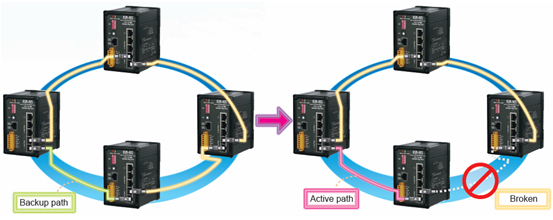 |
Figure 1 |
| |
Dual Ring
The Dual Ring topology can connect separate Cyber-Ring network together (refer to figure 2). It is ideal for two-floor application scene. The Dual Ring topology not only construct individual Cyber-Ring network for each floor but also provide backup path to each other. It is a cost-effective solution to coupling ring topology. |
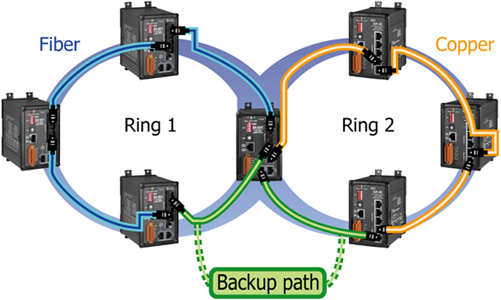 |
Figure 2 |
| |
Double Ring Coupling
Double Ring Coupling is the enhanced version of Ring Coupling topology (refer to figure 3). It improves the reliability of Ring Coupling topology. In Double Ring Coupling topology, there are two coupling points providing redundant coupling path of two rings. |
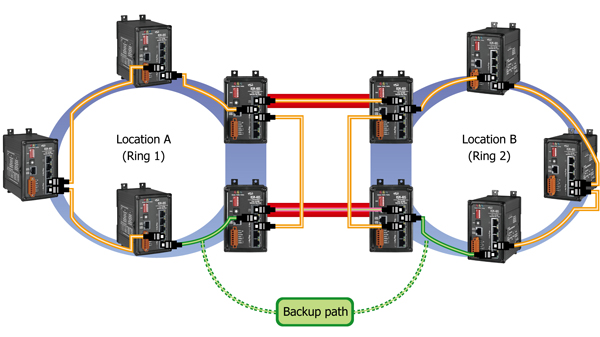 |
Figure 3 |
| |
Solo Ring
A solo Ring network topology based on Cyber-Ring technology is a cost-effective solution to meet the requirements for link-loss backup in redundant network applications (refer to figure 4). Compared with other ring topology, Solo Ring is composed of ONE ring switch and unmanaged switches (NS series), there is some limit of this topology - longer recovery time and the ring switch is used to close ring topology only. The Solo Ring is most cost-effective redundant topology of Cyber-Ring technology. |
 |
Figure 4 |
| |
Coupling
Coupling is an enhanced version of a Dual Ring topology that can be implemented to improve the reliability of Dual Ring network topology by preventing the failure of a single device from affecting the entire network. |
 |
| |
Dual-Homing
Dual Homing is the process of coupling two separate rings using a single FSM switch that is connected to two independent connection points.
If there is only one FSM switch that is easy to connect, or if there is only one FSM switch implemented in a stable environment, then Dual Homing is a better solution. |
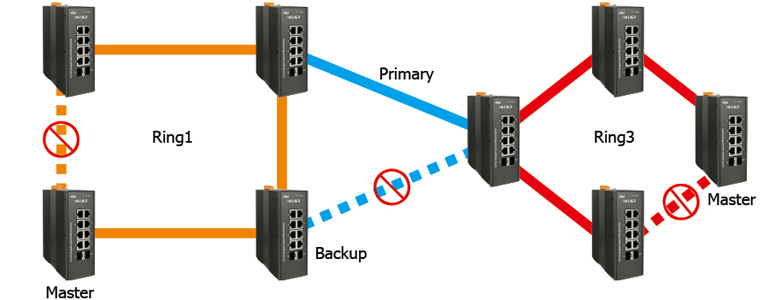 |
| |
Daisy Chain
A Daisy Chain solution can be employed to easily connect and/or extend an existing redundant network,
providing a cost-efficient approach to reconfiguration, since the integration of different
redundant networks can be achieved directly without requiring any ring coupling effort. |
 |
| |
Balanced Chain
Using a Balanced Chain solution, the direction of the traffic can be defined and an individual node can be designated as the central device in order to achieve load balance. |
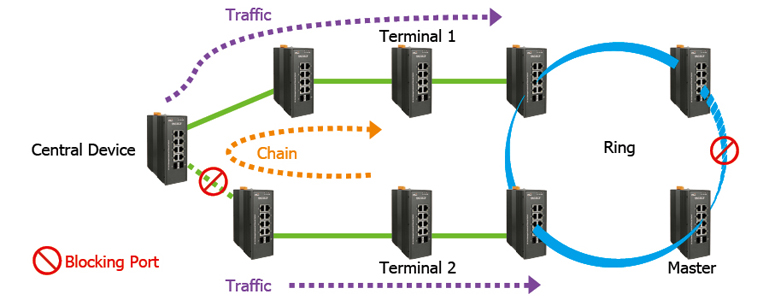 |
| |
|